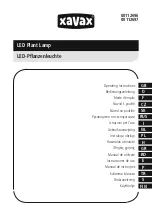
6
V1.0
Occupation of the XLR-connection:
1. Group
2. Signal (-)
3. Signal (+)
DMX OUT
1. Group
2. Signal (-)
3. Signal (+)
DMX IN
If you are using controllers with this occupation, you can connect the DMX-output of the controller directly
with the DMX-input of the first fixture in the DMX-chain. If you wish to connect DMX-controllers with other
XLR-outputs, you need to use adapter-cables.
Building a serial DMX-chain:
Connect the DMX-output of the first fixture in the DMX-chain with the DMX-input of the next fixture.
Always connect one output with the input of the next fixture until all fixtures are connected.
DMX-512 connection with DMX terminator:
For installations where the DMX cable has to run a long distance or is in an electrically noisy
environment, such as in a discotheque, it is recommended to use a DMX terminator. This helps in
preventing corruption of the digital control signal by electrical noise. The DMX terminator is simply an
XLR plug with a 120 resistor connected between pins 2 and 3, which is then plugged into the output XLR
socket of the last fixture in the chain.
Caution: At the last fixture, the DMX-cable has to be terminated with a terminator. Solder a 120 Ω
resistor between Signal (–) and Signal (+) into a 3-pin XLR-plug and plug it in the DMX-output of the
last fixture.
Power connection
Power Requirements
The PAR-350T luminaire operates on 100 to 240 volts AC (+/- 10%, auto-ranging). The luminaire
contains an auto-ranging power supply.
On the rear panel, there is a lockable powercon out. Connect the output with the mains input of the next
fixture until all fixtures are connected.
Note: A maximum of 8 fixtures can be linked together. After every 8 fixtures, the units must have a
renewed connection with the power mains.
Connection with the mains:
Connect the device to the mains with the enclosed power supply cable.
The occupation of the connection cables as below:
Cable color
Connection
International
Brown
Live
L
Blue
Neutral
N
Yellow/green
Earth(Ground)



























